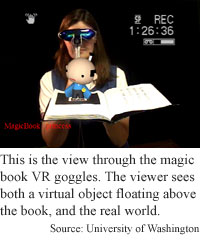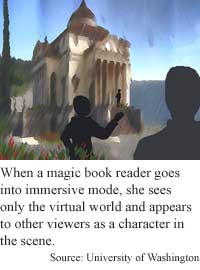
Pop-up books meld real with virtual
By Kimberly Patch, Technology Research NewsResearchers at the University of Washington have produced pop-up books that allow readers to mix virtual reality with real-life collaboration.
The magic book system consists of software, off-the-shelf 3-D goggles or a specialized viewing wand, and a set of actual paper books. Readers don goggles or look through a viewer on the wand to read the books. The software recognizes the book's pictures and adds virtual pop-up displays that float over the pictures.
Readers can also see their real-life surroundings through the goggles, and so can collaborate with fellow readers by, for example, pointing to certain places in the pop-up display.
This all works out because the software uses the black borders surrounding each picture in the book to orient the virtual objects. This way, a reader can turn the book to see different views of the floating, 3-D, picture. Likewise, if one reader sees the front of a pop-up character, a reader sitting across the table sees the back of that same character.
The system's imaging software uses the location of the corners of the picture's black borders to track the orientation of the camera on each reader's goggles or wand relative to that picture, said Mark Billinghurst, a University of Washington researcher. "Because we know where your camera is and because you're holding the camera up to your face we know where your face is relative to the picture," he said.
In addition, using a switch on the wand, readers can enter an immersive mode that allows them to fly into the picture. When several readers are in this mode, they can see each other as virtual figures in the scene. When one reader is in immersive mode and a second is in pop-up mode, the first reader sees the second as a large virtual face looking down from the sky, and the second reader sees the first as a little figure flying around the scene.
When a reader goes into the immersive mode the camera can no longer track where he is looking, so a 3-D compass on the wand takes over. "When you're immersed in the virtual world you can no longer see the real world ... and because of that you can't use the camera to track your head position. So there was a little bit of unique code to write to glue these components together," said Billinghurst.
Finding a pattern in a real-world object, then rendering the pop-up view in the correct perspective for the viewer is "a difficult problem," said Gregory Welch, a research assistant professor at the University of North Carolina. "Properly rendering the character so that it looks correct from your perspective when you look at the book is a nice contribution," said Welch. "It's nice, nice work," he added.
The researchers have written nine children's books that work with the software. Researchers presented the pop-up books at the Special Interest Group Graphics (SIGGRAPH) conference in July, and have since added stereo visuals, which give the virtual object's depth.
The next step is making the virtual world more interactive by allowing readers to manipulate virtual objects, said Billinghurst. "[We're] looking at how people can interact with these models in a more natural manner," he said. "It's one thing to be able to fly into a story or scene and become part of it, but the next step is to really give people the ability to manipulate objects in the scene." For example, a medical student looking at a virtual pop-up anatomy book would be able to cut and suture a virtual organ or limb, he said.
The researchers are also working on combining the technology with projected displays. "The same interaction techniques we [are developing] for the virtual anatomy book will also be interaction techniques we can use for this augmented reality combined with the projection displays," Billinghurst said.
For example, if a two-dimensional map is projected onto a conference room table, a person could use the magic book wand to see a three-dimensional model of the same terrain or additional information about it overlaid on the map. In immersive mode, the person could fly into the three-dimensional terrain and explore it, said Billinghurst.
Working models of interactive books or projection systems could be put together within a year, he said.
The project is a collaboration among the University of Washington, Advanced Telecom Research (ATR) in Kyoto, Japan, and Hiroshima City University in Japan. Billinghurst is heading up the University of Washington research team, Ivan Poupyrev is lead researcher at ATR and Hirokazu Kato is heading up the research at Hiroshima City University.
Poupyrev is using the technology to generate sounds rather than pictures. "As you move the patterns around [the software] generates MIDI sequences. It's a composition application," said Billinghurst. The researchers are planning on combining the two technologies to add sounds to the pop-up applications, said Billinghurst. "That's [a] next step, to have talking books," he said.
The researchers work was funded by Kodak and ATR, which is a government-corporate consortium. The researchers ongoing work will be funded by the National Intelligence and Mapping Agency (NIMA).
Timeline: Now, < 1
Funding: Corporate, Government, University
TRN Categories: Human-Computer Interaction
Story Type: News
Related Elements: Photo 1, Photo 2, Magic Book software downloadable from http://www.hitl.washington.edu/research/shared_space/download/
Advertisements:
October 4, 2000
Page One
DNA does logic
Quantum quirk promises smaller circuits
Pop-up book melds real with virtual
Lab-on-a-CD corrects itself
Linked particles advance quantum computing


News:
Research News Roundup
Research Watch blog
Features:
View from the High Ground Q&A
How It Works
RSS Feeds:
News
Ad links:
Buy an ad link
| Advertisements:
|
 |
Ad links: Clear History
Buy an ad link
|
TRN
Newswire and Headline Feeds for Web sites
|
© Copyright Technology Research News, LLC 2000-2006. All rights reserved.